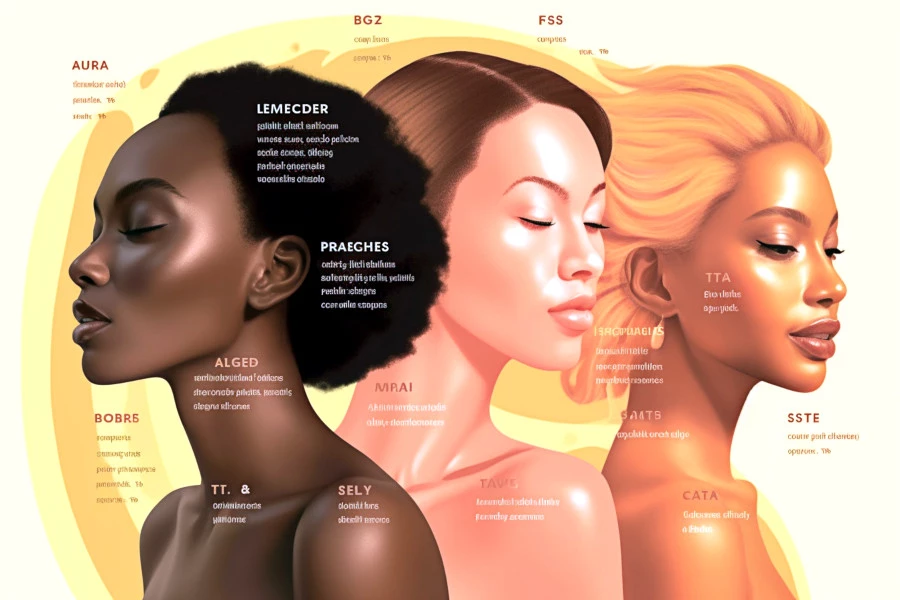In the grand tapestry of humanity, our different types of skin colors are the most visible thread woven through it. With each thread representing a unique blend of color and hue, it’s a testament to the beautiful diversity of our species.
The world around us is awash with color, and it’s this rich tapestry of hues that make our surroundings so captivating. Similarly, it’s the extraordinary diversity of human skin colors, a veritable palette of shades, that adds such fascinating depth to our shared human experience.
Different skin colors represent the fascinating spectrum of humanity, a testament to our shared history and the intricate dance of biology. The world is like a stage where different skin colors play a significant role, contributing to our identities and narratives.
But what is it that dictates the color of our skin? Is it merely a roll of the genetic dice, a geographical influence, or something more? As we navigate through this guide, we aim to unravel the science behind skin color, explore the magnificent range of human skin tones, and delve into how this understanding can help us better care for our skin.
Here are the main topics we’ll be talking about today:
Understanding Different Types of Skin Colors
Understanding different types of skin colors is not just about education, but also, we hope, about inspiring a deeper appreciation for our collective, colorful diversity. Together, we’ll decode the beauty secrets specific to each skin color, ensuring that no matter where you fit on this global color palette, your skin receives the care it deserves.

First, let’s examine the fundamentals behind skin color, the roles of melanin, pigmentation, the Fitzpatrick scale, and the impact of genetics and evolution. Moreover, we’ll touch on the ethnic and cultural considerations that intersect with skin color:
- Skin Color Fundamentals
- Melanin and Pigmentation
- Fitzpatrick Scale
- Genetics and Evolution
- Ethnic and Cultural Considerations
Skin Color Fundamentals
Skin color isn’t simply about being light or dark, it’s a complex interplay of biology and evolution. Two main pigments, melanin and carotene, along with the skin’s level of blood flow, primarily dictate our skin color. The variation in color arises from the differing levels and types of melanin produced by our skin cells.
Melanin and Pigmentation
Melanin is the star of the show when it comes to skin color. Produced by cells called melanocytes, it comes in two forms: eumelanin (brown or black) and pheomelanin (red or yellow). The more melanin produced, the darker the skin color. Intriguingly, all humans have roughly the same number of melanocytes; it’s the melanin production that varies.
Fitzpatrick Scale
To quantify skin’s reaction to sun exposure and assess risk of skin cancer, dermatologists use the Fitzpatrick Scale. It categorizes skin from Type I (very light, always burns, never tans) to Type VI (very dark, never burns, always tans). It’s a vital tool for identifying skin types, especially when considering UV exposure and skin health.
Read more: Fitzpatrick Skin Type: Comprehensive Guide
Genetics and Evolution
Our skin color is an evolutionary gift from our ancestors, sculpted by the sun and geography. Genetics determines how our melanocytes produce melanin. Research has identified several genes involved, such as MC1R, implicated in red hair and pale skin, and SLC24A5, associated with light skin in Europeans.
Ethnic and Cultural Considerations
Ethnicity and culture often intersect with skin color, leading to diverse skin tones within a single racial or ethnic group. These variations highlight the beautiful complexity of skin color. However, it’s important to remember that skin color doesn’t define ethnic or cultural identity, as the same group can encompass a wide spectrum of skin tones.
Categorizing Skin Tones
Skin tones are more nuanced than just being categorized as light, medium, or dark. It’s a whole spectrum.

This section helps us navigate the subtleties of skin undertones and the myriad of skin colors and descriptions that have arisen from these complex interactions:
Skin Undertones and Colors
Every skin color comes with an undertone: a subtle hue underneath the surface. The three main categories are warm, cool, and neutral. Warm undertones lean towards peachy, yellow or golden tones. Cool ones have a blueish, pink or ruddy cast. Neutral undertones are a balance between both. Understanding your undertone can help choose the right makeup or clothing colors.
Read more: Different Skin Tones and Undertones: An In-Depth Guide
Skin Color Descriptions
Skin color descriptions are abundant, varied, and sometimes poetic. From porcelain, ivory, and beige to honey, caramel, and espresso, these descriptors are common. These often overlap with makeup foundation shades, providing a richer language to identify our unique colors.
Skin Color and the Environment
Skin color isn’t a constant. It can change with our environment, sun exposure, and seasons. This section helps us understand these interactions:
Sun Exposure and Tanning
When skin is exposed to sunlight, it produces more melanin, leading to a darker hue or a tan. While a sun-kissed glow is often desired, remember that UV radiation can damage the skin and increase skin cancer risk. Always protect your skin with SPF, regardless of your skin color.
Environmental Influences
Weather can also affect your skin color. Cold, dry climates can make skin paler and more translucent, whereas hot, humid climates may result in a deeper skin tone due to increased melanin production. Even air quality can influence skin health and appearance.
Skin Color Diversity
Skin colors are delightfully diverse, reflecting the global spectrum of human skin tones and the fascinating evolutionary history of skin color. Let’s explore this in more depth:
The Global Spectrum of Skin Tones
The sheer variety of human skin tones is incredible, ranging from the palest ivories to the deepest ebonies and everything in between. This beautiful array of colors is a testament to our shared yet diverse human heritage.
The Natural History of Skin Color
Skin color is a result of human evolution and migration. Our ancestors, living in Africa, had dark skin to protect against the harsh sun. As groups of humans migrated and settled in areas with different sun intensities, skin colors adapted. Less melanin was needed in areas with low sun exposure, leading to lighter skin tones.
Skin Color and the Main Skin Types
The interplay between skin color and skin type can significantly impact skincare needs. This section will examine how the main skin types can be influenced by skin color:
Normal Skin
Normal skin is generally well-balanced in terms of oil and moisture, making it the least problematic skin type. People with normal skin, regardless of their skin color, should focus on maintaining their skin health with regular cleansing, toning, moisturizing, and sun protection.
It’s crucial to note, however, that people with darker skin tones should not skip on sun protection – melanin-rich skin is still susceptible to UV damage.
Read more: Normal Skin: Radiant Skincare Ultimate Guide
Dry Skin
Dry skin lacks enough oil, leading to flakiness, itching, and rough texture. Although dry skin affects all skin colors, melanin-rich skin may exhibit ashy or grayish undertones when dry. To combat this, regular moisturizing and the use of gentle, non-drying skincare products are essential.
Read more: Dry Skin: Radiant Skincare Ultimate Guide
Oily Skin
Oily skin produces excess sebum, leading to shininess and a greater tendency for acne. While all skin colors can have oily skin, the increased melanin in darker skin tones can contribute to post-inflammatory hyperpigmentation once acne subsides. Hence, gentle acne treatments and consistent sun protection are crucial.
Read more: Oily Skin: Radiant Skincare Ultimate Guide
Combination Skin
Combination skin presents oiliness in some areas (usually the T-zone) and dryness in others. This skin type across all skin colors requires careful balancing – hydrating the dry areas while managing oil production in the oily areas. The use of targeted skincare products is recommended.
Read more: Combination Skin: Radiant Skincare Ultimate Guide
Sensitive Skin
Sensitive skin reacts easily to certain products or environmental factors, resulting in redness, irritation, or discomfort. People of all skin colors can have sensitive skin. However, skin reactions may be less noticeable visually on darker skin tones, making it crucial to pay attention to how the skin feels.
Read more: Sensitive Skin: Radiant Skincare Ultimate Guide
Mature Skin
Mature skin is characterized by signs of aging, like wrinkles, fine lines, and age spots. While these signs might appear later for people with darker skin tones due to the natural sun protection from melanin, they can still occur. An effective skincare routine for mature skin should focus on hydration, promoting collagen production, and protecting the skin from further UV damage.
Read more: Mature Skin: Radiant Skincare Ultimate Guide
Remember, even within these skin types, everyone’s skin is unique. The same skin color can have different skin types, and the same skin type can react differently depending on the skin color. Therefore, it’s essential to find out your skin type and take care of it accordingly.
Skincare Products for Different Skin Colors
Skincare is not one-size-fits-all, and your skin color might influence the types of products that best suit your skin. Let’s break down some skincare strategies for different skin colors:
- Skincare for Light Skin
- Skincare for Medium Skin
- Skincare for Dark Skin
- Skincare for Pale Skin
- Skincare for Olive Skin
- Skincare for Brown Skin
- Skincare for Deep-Dark Skin
Skincare for Light Skin
People with light skin often have less melanin, making them more susceptible to sun damage and premature aging. A good SPF is crucial. Look for skincare products that combat redness and sensitivity, common issues for this skin color.
Skincare for Medium Skin
People with medium skin tones often have a combination of skincare concerns from both ends of the spectrum. Depending on the individual, they might need to protect their skin from sun damage, combat hyperpigmentation, or deal with acne scars. A well-rounded skincare routine is important here.
Skincare for Dark Skin
People with darker skin often deal with concerns like hyperpigmentation and uneven skin tone. They would benefit from skincare products that target these issues, along with consistent sun protection, as darker skin can also suffer from sun damage.
Skincare for Pale Skin
Pale skin, characterized by lower melanin levels, may be more prone to sun damage, photoaging, and certain skin conditions like rosacea. It’s essential to prioritize sun protection, wearing broad-spectrum sunscreen of at least SPF 30, and reapplying it every two hours. In addition, pale skin often benefits from gentle, hydrating skincare products, as it can be sensitive or prone to dryness.
Skincare for Olive Skin
Olive skin often tans rather than burns and has a natural resilience to sun damage. However, it’s still crucial to wear sun protection daily. People with olive skin tones often struggle with uneven skin tone or hyperpigmentation, so incorporating brightening ingredients like vitamin C can be beneficial. This skin color may also be more prone to oiliness, making regular cleansing and non-comedogenic products a good choice.
Skincare for Brown Skin
Brown skin has a higher melanin content, providing more natural protection against UV radiation but not exempting it from sun damage entirely. Regular sunscreen use is still necessary. Brown skin is often prone to hyperpigmentation, especially post-inflammatory hyperpigmentation (PIH), following acne or other skin issues. Incorporating skin-brightening ingredients and retinoids can help manage these concerns.
Skincare for Deep-Dark Skin
Deep-dark skin has the highest melanin content, providing substantial natural sun protection. However, sunscreen is still recommended to prevent hyperpigmentation and other forms of sun damage.
Melanin-rich skin is often prone to dryness, so hydrating and moisturizing products should be a staple in your skincare routine. Moreover, deep-dark skin is more prone to keloid scarring and PIH.
Read more: Melanin-Rich Skin Care: How To Nourish And Protect Dark Skin
Embrace Your Place on the Skin Color Spectrum!
Your skin color is a beautiful part of your identity. By understanding the nuances of your particular skin color and its needs, you can ensure your skin stays healthy and vibrant.

And that concludes our comprehensive guide on different types of skin colors. Remember, every skin color is unique and beautiful, and understanding yours will help you care for it in the best possible way!
Celebrate your skin color and care for it well!
Frequently Asked Questions
Before we completely wrap up this guide, let’s address some common questions about skin color, skin types, and skincare:
- What factors determine skin color variations?
- How can I determine my undertone for makeup?
- How are warm, cool, and neutral skin tones different?
- Why do skin tones change throughout the season?
- What is the role of melanin in different types of skin colors?
- How can I identify my type of skin color and skin tone?
- What are the main categories of skin undertones?
- Does my skin color affect how I should care for my skin?
- How does my skin color affect my risk for skin conditions or diseases?
- How can I find makeup that matches my skin color?
- How does skin color affect the appearance of skin issues like acne or scars?
- Can diet or lifestyle changes affect skin color?
- How can I safely enhance my natural skin color?
What factors determine skin color variations?
The primary determinant of skin color is the pigment melanin, produced by cells called melanocytes. Variations in skin color are largely due to genetics, specifically the type and amount of melanin produced.
How can I determine my undertone for makeup?
Look at the veins on the inside of your wrist. If they appear blue or purple, you likely have cool undertones. If they appear green, you have warm undertones. If it’s hard to tell, you may have neutral undertones. Another test is to see whether you look better in silver (cool) or gold (warm) jewelry, or both (neutral).
Read more: Different Skin Tones and Undertones: An In-Depth Guide
How are warm, cool, and neutral skin tones different?
Warm skin tones lean towards peachy, yellow or golden undertones; cool skin tones lean towards pink, red or bluish undertones; and neutral skin tones have a mix of both warm and cool undertones.
Why do skin tones change throughout the season?
Skin tone can appear to change based on the amount of sun exposure you get. In summer, increased sun exposure can lead to a deeper skin tone. In winter, lack of sunlight can lead to a lighter skin tone.
What is the role of melanin in different types of skin colors?
Melanin is the pigment that determines skin, hair, and eye color. Higher levels of melanin result in darker skin tones, while lower levels result in lighter skin tones. Melanin also plays a role in protecting the skin from the harmful effects of UV radiation.
How can I identify my type of skin color and skin tone?
Observe your skin in natural light. Check for overall color (light, medium, dark) and undertones (warm, cool, neutral). For a more scientific approach, you can refer to the Fitzpatrick Scale or seek a professional skin analysis.
What are the main categories of skin undertones?
The main categories of skin undertones are warm, cool, and neutral. Warm undertones lean towards peachy, yellow or golden tones; cool undertones lean towards pink, red or bluish tones; and neutral undertones have a mix of both warm and cool hues.
Does my skin color affect how I should care for my skin?
Yes, your skin color can affect how you should care for your skin. For example, lighter skin tones are more susceptible to sun damage and may require more diligent sun protection. Darker skin tones, on the other hand, can be more prone to hyperpigmentation and may benefit from certain brightening skincare ingredients.
How does my skin color affect my risk for skin conditions or diseases?
Skin color can influence your risk for certain skin conditions or diseases. Lighter skin is more prone to sunburn and skin cancer, while darker skin tones are more susceptible to hyperpigmentation and certain types of scarring. It’s essential to understand your skin’s specific needs and susceptibilities based on your skin color.
How can I find makeup that matches my skin color?
Finding makeup that matches your skin color involves understanding both your skin’s surface color and undertones. Makeup should be tested in natural light and checked for a match on the jawline or the inside of your wrist. Many makeup brands now offer a wide range of shades and undertones to cater to the diversity of skin colors.
How does skin color affect the appearance of skin issues like acne or scars?
Skin color can affect the appearance and healing process of skin issues like acne or scars. Darker skin tones can experience post-inflammatory hyperpigmentation (dark spots) after an acne breakout or injury. Similarly, they are more prone to keloid or hypertrophic scarring. On lighter skin, redness or erythema may be more visible.
Can diet or lifestyle changes affect skin color?
While your natural skin color, determined by genetics, can’t be significantly altered by diet or lifestyle changes, these factors can impact the health and radiance of your skin. For instance, a diet rich in antioxidants can combat dullness and improve your skin’s glow, while certain lifestyle habits, like smoking, can lead to premature aging and a sallow complexion.
How can I safely enhance my natural skin color?
Enhancing your natural skin color safely can involve a range of practices, from maintaining a healthy diet and hydration levels, which can improve your skin’s natural glow, to using cosmetics for a bronzed or luminous effect. Sun tanning is not recommended due to the risk of skin damage and cancer. If you desire a tanned look, opt for sunless tanning products. Always remember that each skin color is unique and beautiful, and it’s most important to focus on maintaining your skin’s health.